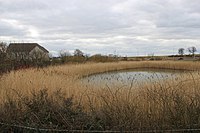
Photo from wikipedia
Abstract Subsurface (tile) drainage is a necessary practice for economic crop production in humid, poorly drained regions of the world. Drainage water management (DWM), also known as controlled drainage, is… Click to show full abstract
Abstract Subsurface (tile) drainage is a necessary practice for economic crop production in humid, poorly drained regions of the world. Drainage water management (DWM), also known as controlled drainage, is among the suite of practices designed to mitigate water quality issues associated with subsurface drainage. Studies evaluating DWM generally include field experiments or simulation models to estimate water quality impacts. Combining field studies with model simulations can provide a more comprehensive assessment. Furthermore, using multiple approaches can provide a range of effectiveness rather than a single estimate, which can help define the uncertainty associated with DWM effectiveness. The goal of this study was to demonstrate the variability in estimated DWM effectiveness using 10 years of measured data and a calibrated hydrologic model. The study field, located in central Ohio, was under a free drainage (FD) mode from 2005 through 2008, and under DWM from 2009 through 2014. We used three approaches to compare discharge and nitrate concentrations and loads: before-and-after, paired-field, and DRAINMOD-NII simulated scenarios. Based on the three evaluation approaches, DWM increased surface runoff by 50% (∼13 mm), reduced annual drainage discharge between 8 and 23% (∼19 to 69 mm), annual mean NO3-N concentrations between −1 and 2.5%, and NO3-N loads between 9 and 25% (∼2.8 to 10.3 kg ha−1 yr−1). DWM also reduced the frequency of drainage discharge, and increased magnitudes of surface runoff, evapotranspiration, and seepage losses. The true magnitude of DWM effectiveness remains somewhat uncertain, especially in fields prone to seepage and runoff losses. However, using a combined assessment approach can help address the uncertainty associated with estimated DWM effectiveness at watershed and regional scales.
Journal Title: Agricultural Water Management
Year Published: 2021
Link to full text (if available)
Share on Social Media: Sign Up to like & get
recommendations!